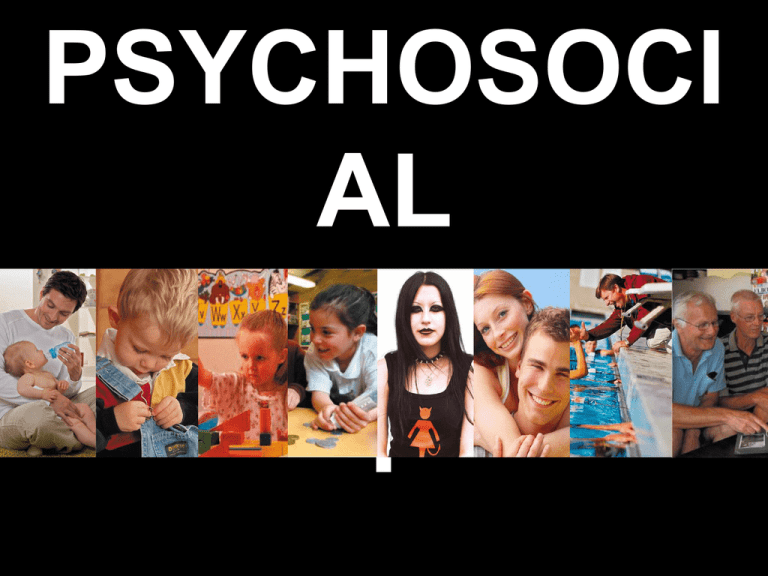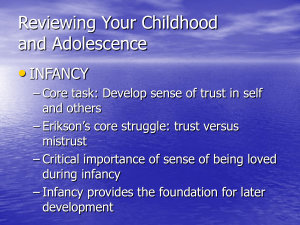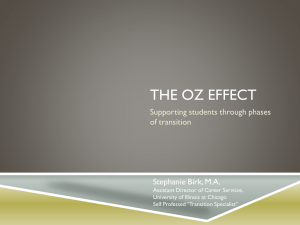
PSYCHOSOCI
AL
DEVELOPMEN
T
By Lisa French, Clarinda McKnight,
Shawny Smith, Ellise Stratton, Jessie West.
There is little doubt that early childhood experiences are important in the
development of social behavior. For instance, the nature of the attachment
formed between an infant and its caregiver/caregivers is viewed by most
psychologists as being vital in emotional development.
Psychologists believe this first social relationship is equally important in
social development. Similarly, many of our social skills develop in early
childhood through interaction with other children during play.
These are just some of the early childhood experiences which
influence the course of social development. Experiences with other family
members, adults, friends, peers, school, work, the media etc also
crucially contribute to the development of social behavior.
One view of the way that social development occurs
throughout the lifespan was described by Danish
psychoanalyst Erik Erikson.
His theory is based on extensive research mainly using
case studies. Erikson studied a range of people living in
different cultures. He also made intensive studies of the
lives of important historical figures.
He believed that social development occurs through a
combination of the effects of psychological processes which
take place within individuals (psycho) and the experiences
during their lifetimes, particularly their interaction with other people (social).
This is why he called his theory psychosocial development. Erikson viewed psychosocial
development as a progression through eight sequential stages, with each stage corresponding
with a different period in the lifespan. In each of these stages, according to Erikson, the
individual has to deal with a different psychosocial crisis that is normal for people in that stage of
life. A psychosocial crisis is a social dilemma or problem an individual faces in adjusting to society.
According to Erikson, our personality and how we interact with others are shaped by how we
deal with or resolve the psychosocial crises. Each crisis involves a struggle between two opposing
tendencies, one of which comes from our internal personal needs and the other from the
demands of society, but both are experienced by the person.
Developmental
Psychosocial
Crisis
Period
Stage
Age
1
Birth to 12 – 18
Months
Early Infancy
Trust vs. Mistrust
2
3
4
18 Months to
3 Years
Late Infancy
Autonomy vs. Shame
or Doubt
3 to 5 Years
Early Childhood
Initiative vs. Guilt
5 to 12 Years
Middle and Late
Childhood
Industry vs. Inferiority
5
12 to 18 Years
Adolescence
Identity vs. Identity
Confusion
6
7
8
18 to 25 Years
Young Adulthood
Intimacy vs. Isolation
25 to 65 Years
Adulthood
Generativity vs. Stagnation
65+ Years
Late Adulthood
Integrity vs. Despair
Erikson used the term trust to refer to
how an infant needs to develop a
healthy sense of trust. This is so they
can perceive the world as a predictably
happy, safe and caring place.
When the world is predictable the
infant can anticipate that they will be
fed when hungry, and when they are
hurt love and care will be given. A
predictable world also means that a
frown or a firm no will be a
consequence to inappropriate behavior.
According to Erikson to grow into a
trustworthy person the care you
receive as an infant is important. These
variations should occur in a way which
helps them learn to anticipate and deal
with it comfortably.
When care is inadequate, irregular
or even rejecting mistrust can
develop. According to Erikson if an
infant develops a strong sense of
mistrust they will become anxious
and insecure. They could also
become suspicious and fearful of
people and the world.
This stage is normally not completely
resolved in infancy. It is also possible
to lost trust because of experiences
later in life.
The second stage, which occurs between 12–18 months and about three years of age,
the conflict that occurs involves autonomy at the one extreme and shame or doubt at
the other.
Erikson believed that successful attempts by infants to establish their independence
during these years contributes to a sense of autonomy.
Autonomy refers to the ability to do things independently and the feelings of selfcontrol, self-confidence, self-reliance and competence which accompanies this.
This is the time when infants gain more and more control over their bodies and aspects
of their behavior.
Toddlers begin toilet training in this stage and exercise autonomy when they gain some
control over their bowel and bladder. This is an important milestone to both parties.
Language skills are another important achievement in developing autonomy. As infants
get better at making themselves understood, they feel more powerful and
independent.
During the second year of life, when infants can move about on their own and have
discovered that they can cause events to occur, they begin to show their independence.
They often want to explore, investigate and do things by themselves. The infant not
only talks and walks, but also climbs, opens and closes things, pushes and pulls, holds
and lets go.
They take pride in these new accomplishments and often want to do things without
help; for example, feeding themselves, buttoning clothes or flushing the toilet. In many
Alternatively, a sense of being too dependent on others can lead to a lack of selfconfidence, self-consciousness and feelings of shame or doubt about our capabilities.
Although it is desirable for autonomy to be developed in this stage, Erikson believed
that a certain amount of self-doubt about our capabilities is appropriate.
Infants need to know the right balance between what they can do, what's safe to do
and what they should do, compared with the activities for which they are not yet
ready.
When the infant's caregivers do for the infant what the infant is capable of doing
themselves, they reinforce a sense of shame and doubt.
When caregivers are consistently overprotective and restrict what the infant is
permitted to do, make fun of unsuccessful attempts at independence and criticize
‘accidents’ (for example, wetting, dirtying, spilling or breaking things), infants can
develop an excessive sense of shame with respect to other people and they begin to
doubt their own abilities to control the world and themselves.
Erikson believed that if the infant leaves this stage with less autonomy than shame or
doubt, they will find it more difficult to achieve autonomy later in life.
According to Erikson, the psychosocial crisis of autonomy versus shame or doubt
which occurs in this stage is based on the infant's developing motor and cognitive
abilities.
The balance between autonomy and shame and doubt set up during infancy can be changed in either positive or negative directions by
later events. In addition, too much autonomy can be as harmful as too little.
For example, consider the actual case of a seven-year-old boy with a heart condition. He learned very quickly how terrified his parents
were of any signs in him that he may have been experiencing heart difficulties. The boy used this problem to rule the household. The
family could not go shopping or for a drive or on a holiday if the boy did not approve. On those rare occasions when the parents took
control and said ‘no!’, he would get angry, his face would become purple and he made gagging sounds. These reactions would frighten the
parents into giving in to him. According to the psychologist who was counseling the family, this boy was actually frightened of the amount
of power he had and was really eager to give it up. When the parents and the boy came to realize this and to recognize that a little shame
and doubt were appropriate for balancing against too much autonomy, the three were able to develop a healthier relationship.
The third stage, which occurs between about three and five years
of age, involves a conflict between initiative at the one extreme
and guilt at the other.
Having established a sense of trust and autonomy in infancy,
children develop an increasing sense of their own power and now
want to try new things and use their power. According to Erikson,
initiative involves being able to plan, think for oneself and carry
out various kinds of activities with purpose.
Children from three to five years of age (are very active and
increasingly have more control over their bodies.
Their mental capabilities are also developing. They have good language skills, they are inquisitive, they participate in
imaginative play, and they are beginning to understand that other people have different thoughts and feelings from
them.
They also start to realize they can make things happen. Children at this age no longer merely react. They plan and
think for themselves, act with purpose, explore and follow their curiosity. They can therefore initiate and carry out
various activities on their own, often just for the sake of being active. They no longer just respond to or imitate the
actions of other children.
On the other hand, children in this age group also become increasingly aware
that there are limits beyond which they must not go when showing initiative and
using their powers.
For example, they become aware of rules about what is (and what is not)
permitted, what will (and what will not) be tolerated, and even questions they
should not ask.
Thus, along with initiative comes the potential for feeling guilt — about going
too far, about overstepping boundaries, about asking too many inappropriate
questions, about becoming the ‘wrong kind of person’.
For example, consider the case of five-year-old Sumi who feels so angry at her
little brother that she wants to hit him. Sumi also realizes that hitting her brother
is wrong and that this action would upset her parents. She knows she has the
ability to hit her little brother, but realizes she cannot always do what she wants.
She also realizes that she will feel guilty if she fails to control her behavior.
In the autonomy stage (stage 2), children can be made to feel ashamed by other
people; whereas in this third stage they learn to make themselves feel ashamed.
According to Erikson, whether or not a child leaves this stage with a stronger sense of initiative than guilt depends largely on
the way in which caregivers respond to the child's self-initiated activities.
Children who are given a lot of freedom and the opportunity to initiate play activities simply for the sake of doing them will
have their sense of initiative strengthened.
Initiative is also strengthened when caregivers answer their children's questions (intellectual initiative) and do not discourage
or make fun of their fantasies.
On the other hand, if children are made to feel that their play is silly and stupid, that their questions are annoying or a
nuisance, and that fantasy is a waste of time, then they may develop a sense of guilt over self-initiated activities, feelings that
may continue through later stages.
The fourth stage, which occurs between about five and 12 years of
age, involves a conflict between industry at the one extreme and
inferiority at the other. During this period children have a desire to
learn how things are made, how they work and what they do.
According to Erikson, children will develop a strong sense of industry,
unless they are restricted by feelings of inferiority or inadequacy.
During this stage of development, children gain mastery over their
bodies. It is also a period during which they become capable of logical
reasoning, and of playing and learning by rules.
Although play continues to be important, as it is in all other stages,
this is the period when the child must learn to work and become
productive.
According to Erikson, children must learn the technology or ‘tools’
which are important for being an industrious, productive worker in
their society.
At school, the child also learns to be a worker and to earn recognition by producing things of quality, both by themselves and with
others.
Importantly, school also exposes the child to many peers with whom they cooperate and compete, and against whom they measure
their abilities and accomplishments. To the five-year-old child, entering school is like entering a new world which is different from home.
In many respects, school is a social world with its own goals, rules, achievements and failures.
When children are encouraged in their efforts to get the most out of
things they already have, to do practical things (whether it be to cook,
assemble a jigsaw puzzle, or construct a cubby house), are allowed to
finish their products and are praised and rewarded for their results,
then their sense of industry is enhanced.
But parents who see their children's efforts as ‘mischief’ and ‘making
a mess’ promote the development of a child's sense of inferiority.
When children feel less adequate than their peers in achievements,
skills and abilities, they develop a sense of inferiority.
The child's school experience also affects their industry–inferiority
balance. For example, a child who has difficulties with schoolwork can
have a particularly unhappy school experience, even when their sense
of industry is encouraged and rewarded at home.
This child may be ‘too bright’ to be in special classes, but ‘too slow’ to
compete with children of average ability.
Consequently, the child regularly experiences failure in academic
efforts and this reinforces their sense of inferiority.
On the other hand, children who have their sense of industry
‘squashed’ at home can have it revitalized at school through a
sensitive and encouraging teacher.
Therefore, whether the child develops a sense of industry or
inferiority does not depend solely on the care giving efforts of the
parents (as it does in earlier stages), but on other significant adults in
the child's life as well.
The fifth stage, which occurs between about 12 and 18 years of age, involves resolving
the conflict between identity at the one extreme and identity confusion at the other.
During this period the psychosocial crisis involves developing a sense of identity.
Failure to resolve this crisis produces ‘identity confusion’.
Erikson used the term identity to refer to the overall image individuals have of
themselves. Erikson believed that identity is something all people seek and the search
for identity is a lifelong search. However, it first comes into focus during adolescence.
During adolescence, the individual matures cognitively as well as emotionally and
physically.
In addition to the new feelings, sensations and desires that are experienced as a result
of bodily changes, the adolescent develops a variety of new ways of looking at and
thinking about the world.
Among other things, adolescents can think about how other people think and contemplate what other people think of them.
They can also form clear ideas about ideal families, religions and societies which they can then
compare with their own experiences of family, religion and society.
Erikson believed that the task of this fifth stage is for adolescents to use their cognitive abilities to bring together all the things they have
learned about themselves in the various roles they have undertaken in life; for example, as a son or daughter, brother or sister, student,
sportsperson, friend, leader, follower, musician, employee and so on.
The different images of the self learned through these different roles need to be integrated, or pulled together, into a complete image of the
whole person that makes sense and that shows continuity with the past while preparing for the future. The adolescents who succeed at this
task develop a psychosocial identity, a sense of who they are, where they have been and where they want to go in life.
If the person has reached adolescence with a healthy sense of trust,
autonomy, initiative and industry, then their chances of developing a
meaningful sense of identity are much better.
The opposite is true for the person who enters adolescence with
considerable mistrust, shame, doubt, guilt and inferiority.
According to Erikson, preparation for a successful adolescence and forming
an integrated psychosocial identity must, therefore, begin in infancy.
When young people do not attain a sense of personal identity, they show a
certain amount of role confusion — a sense of not knowing who they are,
where they belong, to whom they belong or where they are headed in life.
According to Erikson, such confusion is often seen in delinquent young
people. Some young people seek a ‘negative identity’ opposite to the one
that their parents and relatives would prefer them to have; for example, an
identity as a ‘delinquent’, ‘druggie’ or an ‘emo’.
Role confusion may also be evident when a young person takes an excessively
long time to reach adulthood.
However, a certain amount of identity confusion is normal and, according to
Erikson, helps explain the inconsistency, or changeable nature, of much
adolescent behavior, as well as adolescents’ self-consciousness about their
appearance.
Failure to establish a clear sense of personal identity during adolescence does
not mean that a person is a failure or will never establish a strong sense of
who they are. People who attain a sense of identity in adolescence will still
come across challenges to that identity as they move through life.
The sixth stage of psychosocial development which occurs between about 18
and 25 years of age, involves a conflict between intimacy at the one extreme
and isolation at the other.
Failure to resolve this conflict results in avoiding interpersonal relationships and
experiencing a sense of isolation.
Erikson used the term intimacy to refer to the ability to share with and care
about another person without fear of losing oneself in the process. Isolation
refers to the sense of being alone without anyone to share one's life with or
care for.
During later adolescence and the early years of adulthood, it becomes possible
for the first time to engage in a truly intimate relationship with another person
outside the family; to love another person for their real qualities and not just
for the satisfaction that can be obtained from the relationship.
According to Erikson, this kind of relationship cannot occur earlier in life because a person cannot establish true intimacy without
first developing a strong sense of personal identity and independence and being secure in their place in the world.
According to Erikson, intimacy does not necessarily involve sex and it includes the relationship between friends.
For example, soldiers who have served together under the most dangerous circumstances often develop a sense of commitment to
one another that illustrates intimacy in its broadest sense.
If a sense of intimacy is not established with friends or a partner, the result, in Erikson's view, is a sense of isolation.
People who do not fully understand who they are find it
difficult to deal with the complete and open sharing that is
required in an intimate relationship.
Erikson's description of intimacy versus isolation may
provide some insight into people who say ‘I'm not ready for
a committed relationship’.
Furthermore, a person without a strong sense of identity
tends to frequently seek praise, flattery and adoration from
others, and this interferes with the shared commitment and
honest communication that are essential for an intimate
relationship to develop and last.
People who lack a sense of identity tend to isolate
themselves, or form superficial or shallow relationships with
others.
As with other psychosocial crises, the development of
intimacy does not occur only during the stages of late
adolescence and young adulthood.
Nor do individuals stop seeking intimacy after the early
adulthood stage. Intimacy, like identity, continually changes
over time and is influenced by experiences later in life.
Generativity refers to a persons concern with
others such as future generations, the nature
of society and the world in which the
generation will live in.
This is achieved by helping others and/or
make the world a better place in which to live.
If Generativity is not achieved people develop
a sense of stagnation.
According to Erikson having children is an
important part of Generativity but this does
not mean that everyone who has children are
generative nor does it mean you cant be
generative and not have kids.
According to Erikson, becoming
generative is not always easy. It
depends on the successful resolution
of the crises in each of the previous
six stages.
stagnation refers to boredom,
inactivity, lack of personal growth
and too much concern with personal
needs.
To achieve this stage you would have
to successfully resolve the crisis's in
each of the previous 6 stages.
You need a balance of positive and
negative aspects of each crisis to
achieve it.
The eighth stage, which occurs after about 65 years of
age, comes at a time when most of a person's life's
work is nearing completion and there is time for
reflection. The last psychosocial crisis to be faced is
integrity versus despair.
According to Erikson, the sense of integrity arises
from the individual's ability to look back on their life
with satisfaction. Integrity refers to a sense of
satisfaction with one's achievements in life and a
belief that all that happened in the course of one's life
has been useful, valuable and meaningful.
The major part of life has been lived and the crisis of
integrity involves an examination of that life and a
judgment of whether that life, with all its ups and
downs, gains and losses, good decisions and mistakes,
pleasures and pains, was worthwhile.
At the other extreme is the individual who looks
back on life with a sense of despair.
Despair involves bitter feelings of hopelessness,
involving lost opportunities, mistakes that were
made and the sense that life has been
meaningless and empty. In the latter years of
life, the individual may realize with despair that
time seems to have run out and it is too late to
do all the things they want to do.
While a person must achieve a greater sense of
integrity than despair for the successful
resolution of the final crisis, Erikson believed
that some despair is inevitable.
For example, he suggested that even if someone
felt completely fulfilled with their life, the fact
that other people have suffered throughout
their lives may make them feel some despair.
Erikson's psychosocial theory provides a useful outline for understanding aspects of psychosocial development and interpreting some of the
major changes that occur at different times throughout the lifespan. Unlike many other theories on development, Erikson's theory describes
changes which take place across the entire lifespan from birth to older age. Another positive feature of Erikson's theory is that it describes how
healthy social (and personality) development is achieved. He explains how each stage of development can have a positive outcome as well as a
negative outcome. This balanced view of psychosocial development is a feature which made Erikson's theory appealing to clinical psychologists
and psychiatrists who sometimes use it in their work with people of all ages. In his theory, Erikson recognized that parents (especially the
mother) are important influences on psychosocial development. However, his theory is different from other theories in its emphasis of the role
of individuals in their own psychosocial development, and of the influences of the social world to which the individual belongs. Erikson
recognized other important influences in the individual's world, such as the father, siblings, other caregivers, the school, friends, peers, the wider
social environment and the individual's own characteristics.
Criticisms of Erikson's theory have been based on the lack of experimental evidence to support it. His theory is developed mainly from case
studies of people in several different cultures and on his experiences with individuals he counseled, rather than scientifically controlled research.
Experimental evidence for Erikson's theory has been difficult to obtain because of the problems with examining each of the stages under
controlled conditions. For example, it is hard to define ‘basic trust’ precisely enough for thorough scientific testing in a laboratory setting.
However, in the past 15 or so years, various research attempts have been made to test Erikson's theory using cross-sectional and longitudinal
studies. Findings from these studies indicate some empirical support for aspects of Erikson's theory.
Another criticism of Erikson's theory is that it did not consider the way in which socio-cultural influences have differing effects on males and
females. For example, Erikson failed to describe female psychosocial development in general and his theory primarily describes male
psychosocial development.
Criticisms have also been made about more specific aspects of Erikson's theory; for example, Erikson's belief that identity is found in
adolescence. Australian psychologists Lindsay Gething and Desmond Hatchard suggest people continue their search for identity well into young
adulthood. They also criticize Erikson's theory for overlooking the role of work in identity formation of the young adult. They believe this is a big
gap in the theory, especially as Erikson strongly argued about the importance of industry in childhood and the importance of career preparation
in adolescence. Many recent studies of adult development have shown that undertaking a career during adulthood is a major path in the search
for identity. Furthermore, experiences at the workplace can affect our social development as much as people with whom we have relationships.
Erikson's theory states that all people experience a ‘mid-life crisis’ during adulthood. However, research which has tested this proposal suggests
that this is not the case.
http://www.youtube.com/watch?v=dGFKAfixHJs&feature=channel










